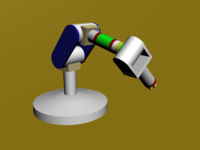
Photo from wikipedia
With mechanical loading as the main risk factor for LBP, exoskeletons (EXO) are designed to reduce the load on the back by taking over part of the moment normally generated… Click to show full abstract
With mechanical loading as the main risk factor for LBP, exoskeletons (EXO) are designed to reduce the load on the back by taking over part of the moment normally generated by back muscles. The present study investigated the effect of an active exoskeleton, controlled using three different control modes (INCLINATION, EMG & HYBRID), on spinal compression forces during lifting with various techniques. Ten healthy male subjects lifted a 15 kg box, with three lifting techniques (free, squat & stoop), each of which was performed four times, once without EXO and once each with the three different control modes. Using inverse dynamics, we calculated L5/S1 joint moments. Subsequently, we estimated spine forces using an EMG-assisted trunk model. Peak compression forces substantially decreased by 17.8% when wearing the EXO compared to NO EXO. However, this reduction was partly, by about one third, attributable to a reduction of 25% in peak lifting speed when wearing the EXO. While subtle differences in back load patterns were seen between the three control modes, no differences in peak compression forces were found. In part, this may be related to limitations in the torque generating capacity of the EXO. Therefore, with the current limitations of the motors it was impossible to determine which of the control modes was best. Despite these limitations, the EXO still reduced both peak and cumulative compression forces by about 18%.
Journal Title: Journal of biomechanics
Year Published: 2019
Link to full text (if available)
Share on Social Media: Sign Up to like & get
recommendations!